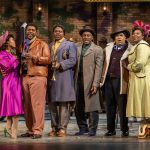VITAL Features
A part of the solution
In the auditorium of the John C. Cudahy YMCA, the basketball hoop blocks the view of the stage. Kendall tells the lanky teens shooting hoops to go upstairs for a while so Scott can set up his tripods, flashes and umbrellas. This is the only YMCA in the country built specifically to accommodate the arts. Set on 55 acres of wooded land – formerly John C. Cudahy’s farmstead – and home to a “safe place” where teens can study, use computers and play sports and video games, it’s a far cry from the popular image of the Y as a fitness club, a place to play racquetball and run laps on the track. Kendall Hayes, now 20, joined AmeriCorps right out of high school. He’d been working so many hours at the branch’s front desk as part of STEP-UP (a career development program for high school students run by the county’s Private Industry Council) that a friend suggested he might as well earn volunteer hours and collect an education award as a full-fledged AmeriCorps member. Now he’s in his second year of service at the YMCA, where he helps students in the teen program with everything from homework and test preparation to setting up bank accounts and working creatively. “[I try] to get kids to stay active, to get them to expand their horizons and open them up to new things,” he says, “not just coming here to play basketball every day, but getting them to do something artsy, or getting them to go back and help their community.” Right now, Kendall is working on developing an art guild for the teens that would incorporate creative writing, music and visual art. AmeriCorps members can serve a maximum of two terms and qualify for the education award, and when his term is up, Kendall plans to go to the University of Wisconsin-Milwaukee, maybe to study recording arts and psychology. “I’m the type of person that likes to do everything, [and] AmeriCorps has offered new possibilities for me … We’ve [done everything from] helping inner city youth to working on Philadelphia Community Farm to disaster relief training,” he says. “[But] going back to school is a whole different section of my life.” Still, he says, “I do wish that I could stay longer. There’re a lot of different opportunities and I don’t feel that I’ve experienced it all. And I’m always willing to lend a helping hand.” Kendall’s commitment to public service is unadorned, stunningly simple. In our interview, he speaks gracefully about what service can do for communities – and what community service gives to those who serve. The organization In 1993, then-President Bill Clinton established AmeriCorps as the country’s flagship service initiative. It’s often assumed to be a single program, like the domestic version of the PeaceCorps, but AmeriCorps is actually a network of organizations, a bear hug that encompasses four primary programs: AmeriCorps*State and AmeriCorps*National, which provide funding and volunteer resources to statewide and national organizations; the National Civilian […]
Jan 1st, 2008 by Amy ElliottWhat Gives?
By Kenya Evans, Brian Jacobson, April Jones & Amy Elliott DONATIONS One fairly obvious – and fabulously generous – gift that gives is a donation in someone else’s name. These unique organizations won’t leave your recipients snarling wicked holiday wishes under their breath. a. Ducks! Real, live ducks! $20 Heifer International – heifer.org Who’d imagine a mule, a cow or some simple farming tips had the power to alleviate poverty, hunger and the degradation of the earth? Heifer provides an incredible opportunity for communities in developing countries; sustainability is instilled through training, the offspring of gift-animals spread the wealth and spread hope, dignity and self-reliance in the neighborhood. A flock of ducks ($20) can almost triple a family’s income in China. Give a bicycle and more! $46 – $100 World Gifts – worldgifts.cafod.org.uk World Gifts works with more than 500 partners to help poor countries find long-term solutions. You give a gift, and someone else gets a gift from CAFOD, the Catholic aid agency. Worms for composting plus seeds and tools for sowing runs about $46, a bicyle runs around $100. Your gift buys a bicycle for a health worker who can more easily travel to remote villages in poor countries to treat or prevent killer diseases. A bicycle also allows health workers to bring comfort and advice to the sick and their families when they need it most. An amazing gift for the cyclist in your life. Support small business $25 Kiva – kiva.org Maybe you’re an honorary loan officer for your kids or your unlucky friends, but Kiva gives you the opportunity to lend to entrepreneurs in impoverished communities across the globe, empowering them to “lift themselves out of poverty” and into economic independence. Kiva partners with microfinance institutions to ensure that endeavors are legit. The best part is that you’re helping people who are on their way to financial freedom. ORGANIC AND NATURAL With smaller local farmers struggling, this niche market is a lifesaver. Established and neophyte grocery and specialty shops in Milwaukee have ready-to-give holiday items; some even have online ordering and cross-country shipping. Beans and Barley gift card $40 Beans and Barley – beansandbarley.com 1901 East North Ave. 414-278-7878 An eclectic health food market and a popular café, this East Side institution also has artsy offerings for stocking stuffers. A $40 café gift certificate for two should cover the works: drinks, appetizers, dinner and maybe even a scrumptious dessert. Giftcards may be purchased in any amount. VITAL does not recomend stuffing stockings with actual appetizers, drinks or desserts. Outpost Natural Foods ownership $25 Outpost Natural Foods outpostnaturalfoods.coop Wauwatosa, Bay View and Capitol Dr. in Milwaukee 414-431-3377 Milwaukee’s original food co-op now sports three area locations. Buy someone a one-year “ownership” for $25 and they’ll get special discounts, rewards and the monthly Exchange Magazine. Teach your kids a lesson in responsibility by allowing them to invest in something that will not leave a stain your carpet or wear out the tube on your TV. b. Oskri […]
Dec 1st, 2007 by Amy Elliott“Keep guard over your EYES AND EARS as the inlets of your heart …” — Anne Bronte
The percussion of two eyelids meeting during a blink is not audible to the human ear, which consists of fibro-elastic cartilage covered with skin and fine hairs. In contrast to the eyes, the ears are always working. Visual reality is limited to a single, blinking field of vision and sight requires the tireless work of the ears to give it direction. Thus sight is aided by the ears, but rarely are the two given equal attention onstage. The Milwaukee Symphony Orchestra will address the disparity between sight and hearing this season by presenting two concerts featuring music written specifically for the eyes. In April, the MSO performs the score to Charlie Chaplin’s City Lights as the film is projected overhead at The Marcus Center. Earlier on, the MSO will perform a special Halloween concert featuring scores written for Alfred Hitchcock films. Hitchcock worked with such influential film composers as Bernard Hermann, Dimitri Tiomkin and Franz Waxman, so this could be profoundly good. The work of another composer who wrote largely for the eye will be included on a concert at the Wilson Center in September as visually appealing Grammy-nominated vocalist Monica Mancini performs on the 15th. Included will be songs written by her father Henry, who wrote scores for over a hundred films in his lifetime (The Glenn Miller Story, Breakfast at Tiffany’s, The Pink Panther ). Monica will perform some of her father’s songs (such as “Moon River” and “Dear Heart” ) to clips of the films in which they appeared. In the realm of more contemporary film music, The Waukesha Symphony Orchestra will present Corigliano’s Suite for Violin and Orchestra from his Academy Award-winning score to The Red Violin. The WSO will be joined by American virtuoso Maria Bachman – one of Corigliano’s favorite violinists. In a similar hybrid of film and music, The Skylight Opera closes its season with Nine: The Musical. Written by Maury Yeston and Arthur Kopit, this Broadway hit is an oddly skewed adaptation of film legend Frederico Fellini’s autobiographical masterpiece 8½. The musical adaptation of Fellini’s highly surrealistic and self-referential film may seem like something of a curiosity, but the show was a big hit on Broadway. The Skylight has a flair for putting together visually appealing presentations, so it will be interesting to see how they render what should prove to be a very interesting evening of musical theatre.
Sep 1st, 2007 by Russ Bickerstaff“THE HEART has reasons that reason cannot know.” — Blaise Pascal
Radiance and darkness come from the same place. If the mind is the brightest place in the human body with its constant storm of electrical impulses, perhaps the human body’s darkness exists in the heart – a place of absolutely essential, tireless labor. The heart creates enough pressure in the course of its constant pumping to shoot blood out of the body up to 30 feet. It can continue pumping even after 1/3 of its muscle mass is decayed. In spite of this, what is strong and durable from within is also quite fragile from the outside. It only takes 25 to 75 watts of electricity to stop the heart from beating. Somewhere in every beat lurks the final one, pumping blood to darker veins on the other side of human consciousness. This season promises some particularly dark moments. In May, Windfall Theatre travels into a conspicuously bleak autobiographical musical with William Finn’s A New Brain. Finn chronicled his battle with brain cancer in a musical filled with more heart and true human emotion than most musicals ever aspire. The Skylight Opera launches a completely different take on the dark side of musical theatre with a production of The Midnight Angel at the end of September. It’s the story of a wealthy 18th century woman so bored with life that she throws a lavish, decadent ball, inviting Death itself as a guest of honor. A similarly dark specter descends upon the Waukesha Civic Theatre’s Concert Series this season with Igor Stravinsky’s The Soldiers Tale. It’s a brilliantly dark piece usually performed by seven instruments. Composed in 1918, it’s based on an old Russian folk tale about a deserting soldier who meets and loses his soul to the Devil. In February, Milwaukee Chamber Theatre presents its stage adaptation of the dense, gritty work of Russian darkness that is Dostoyevsky’s Crime and Punishment. The heavily intricate story of the brutal axe murder of two women will be played out sparingly. It will take a particularly deft scalpel to bring the extensive complexity of the original novel to the stage with three actors in a 90-minute show, but with the unique talents of Drew Brhel, Leah Dutchin and Mic Matarrese under the direction of Patrick Holland, Milwaukee Chamber’s Crime and Punishment could be one of the better shows on local stages this season. Under an even deeper pall of surreal darkness, The Milwaukee Rep presents Samuel Beckett’s vision of The End next March. Mark Corkins stars in Endgame as Hamm, who sees the final curtain falling and a new one rising. Another classic tale of dystopia makes its way to Wisconsin Lutheran College’s Theatre Department with George Orwell’s 1984. The title may be out of date, but the concept of a world watched over by the all-seeing Big Brother is a very interesting choice for WLC. Earlier in the season, WLC also presents a pair of one-acts about the darker aspects of time, including playwright Susan Glaspell’s intriguing short drama Tickless Time. Written […]
Sep 1st, 2007 by Russ Bickerstaff















